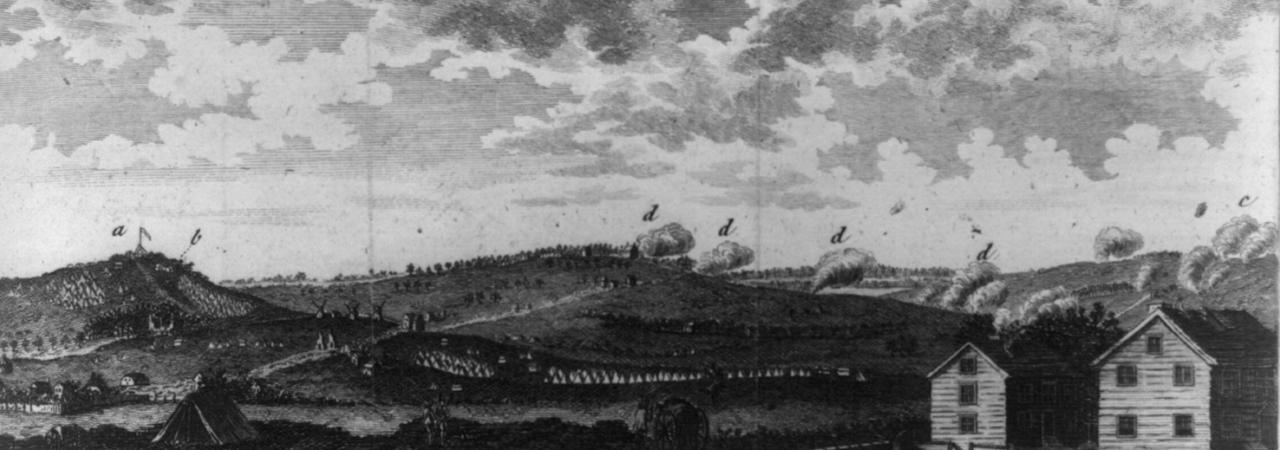
Rhode Island
Siege of Newport/Battle of Quaker Hill
Rhode Island | Aug 29, 1778
The Battle of Newport, Rhode Island sometimes called the battle of Quaker Hill and the Siege of Newport took place on August 29, 1778 and is noteworthy that it was one of the first combined American-French military operations of the war, and that the 1st Rhode Island Infantry, a brigade of composed a mixed racial element of European Americans, American Indians, and many African Americans, saw action.
Newport, occupied by the British since late 1776, had been under siege for most of the war. After the American’s under the command of Brigadier General John Sullivan lifted the siege, the British unexpectedly moved out of their fortifications to attack Sullivan’s rear guard. A fierce firefight erupted. Sullivan had expected French support but poor weather, bad feelings generating ill will between the Allied commanders, and shifting tides, prevented the French from both naval and amphibious operations in coordination with the Americans. Commanding the British garrison at Newport was General Sir Robert Pigot.
In early May 1778 Sullivan began to lay out his plan for taking Newport. British intelligence followed Sullivan’s efforts. In July, George Washington ordered Sullivan to raise 5,000 troops. On July 23 Sullivan received Washington’s orders, but the next day Colonel John Laurens arrived at Sullivan’s camp advising him that reinforcements were on the way in the form of Continental Army troops led by the Marquis de Lafayette. This news bolstered American morale and the countryside and militia units from across New England began pouring in. Nathanael Greene, a Rhode Island native had also been dispatched by Washington to provide Sullivan counsel.
Sensing an opportunity, the American commander called for a Council of War on July 29 including French admiral, the Comte d’Estaing. Newport is located on Aquidneck Island and Sullivan suggested that American forces attack from the east while French forces would launch their assault from the west in an effort to isolate British forces located on Butt’s Hill on the northern end of the island.
Pigot quickly figured out the Allied plans. He consolidated all the British forces on Aquidneck Island into Newport, secured the islands livestock, leveled orchards in front of the city so that the British could have a clear field of fire, ordered all carries and wagons destroyed. Meanwhile, under pressure from the French Navy, several British ships ran aground, which the British scuttled by fire so they could not be captured. D’Estaing’s fleet sailed into Newport Harbor on August 8. The next day the French Admiral disembarked his troops, but meanwhile having learned Butt’s Hill had been evacuated, Sullivan decided to seize it thinking the British might try to regain the high ground. According to Laurens, Sullivan’s move, “gave much umbrage to the French officers.”
Meanwhile British Admiral Sir Richard Howe’s fleet from New York arrived to challenge the French Navy. A raging Atlantic storm on August 10 and 11 severely damaged both fleets. Prior to the storm D’Estaing ordered the French infantry to reboard the ships and informed Sullivan he was sailing to Boston for repairs. Sullivan felt abandoned, convinced that the plan unfolding would force British capitulation of Newport in a matter of days. Sullivan wrote that D’Estaing “left us in a most rascally manner.”
In the interim the British decided to reinforce Newport with an additional 4,000 men.
With the situation in flux, Sullivan decided to abandon the siege on August 28. American deserters in the meantime informed Pigot of Sullivan’s plan. To protect his rear Sullivan ordered a defensive position across the entire island.
The American defensive line was broken into two sections. Greene was on the west deployed in front of Turkey Hill with the 1st Rhode Island Infantry deployed a half mile south. They were under the command of General James Varnum on his eastern flank were John Glover’s men concentrated in a fine defensive posture behind stone walls able to clearly see Quaker Hill.
Pigot’s forces followed closely on Sullivan’s heels and ordered two columns to pursue the Americans but avoid a general engagement, however the fog of war intervened and a main battle erupted. The Americans fought stubbornly giving up little and holding onto their defensive lines as well as the high ground. Fighting on the American left finally subsided when the British decided the American position was too strong.
The Battle of Newport is often overlooked in the annals of the American Revolution, but it is important, if not only for the role of the 1st Rhode Island infantry.
Related Battles
10,100
6,700
181
260


